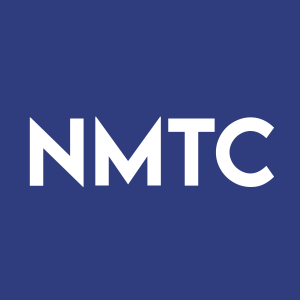NeuroOne® Awarded U.S. Patent Covering Novel and Proprietary Thin Film Electrode Platform
NeuroOne Medical Technologies Corporation (NASDAQ: NMTC) announced the award of a new patent for its innovative thin film neural depth electrode technology. The patent, titled "Improved Neural Depth Probes and Related Systems and Methods," enhances the company's intellectual property portfolio, which now includes three licensed patents, eight pending applications in the U.S., and several foreign applications.
This technology aims to improve surgical outcomes for various neurological disorders, including epilepsy and Parkinson's disease. CEO Dave Rosa emphasized the company's commitment to advancing its electrode technology and securing its proprietary methods.
- Awarded a new patent for innovative thin film neural depth electrode technology.
- Patent enhances NeuroOne's intellectual property portfolio, including three licensed patents and eight pending U.S. applications.
- Technology has potential applications for various neurological disorders, improving surgical options and outcomes.
- Uncertainties surrounding the clinical and regulatory pathways for new technology.
- Risks associated with market acceptance and commercialization efforts.
- Dependence on external factors like supply chain issues and labor shortages.
Insights
Analyzing...
New patent adds value to NeuroOne's growing patent portfolio in the
The patent, titled "Improved Neural Depth Probes and Related Systems and Methods," adds to NeuroOne's intellectual property portfolio, and is focused on a layered thin film neural depth electrode. The electrode could have potential applications in a wide variety of neurological procedures for both diagnostic and therapeutic use. Conditions that could potentially benefit from this technology include epilepsy, Parkinson's disease, chronic back pain due to failed back surgeries, and mood- based disorders associated with depression, severe OCD, etc.
In addition to this patent, NeuroOne's patent portfolio includes three licensed patents, eight pending
About NeuroOne
Forward Looking Statements
This press release may include forward-looking statements within the meaning of Section 27A of the Securities Act of 1933, as amended, and Section 21E of the Securities Exchange Act of 1934, as amended. Except for statements of historical fact, any information contained in this presentation may be a forward–looking statement that reflects NeuroOne's current views about future events and are subject to known and unknown risks, uncertainties and other factors that may cause our actual results, levels of activity, performance or achievements to be materially different from the information expressed or implied by these forward-looking statements. In some cases, you can identify forward–looking statements by the words or phrases "may," "might," "will," "could," "would," "should," "expect," "intend," "plan," "objective," "anticipate," "believe," "estimate," "predict," "project," "potential," "target," "seek," "contemplate," "continue, "focused on," "committed to" and "ongoing," or the negative of these terms, or other comparable terminology intended to identify statements about the future. Forward–looking statements may include statements regarding the development of the Company's electrode technology program, applications for, or receipt of, regulatory clearance, applications for, or receipt of, patent protection, potential applications for existing patents, the timing and extent of product launch and commercialization of our technology, clinical and pre-clinical testing, what the future may hold for electrical stimulation and NeuroOne's potential role, business strategy, market size, potential growth opportunities, future operations, future efficiencies, and other financial and operating information. Although NeuroOne believes that we have a reasonable basis for each forward-looking statement, we caution you that these statements are based on a combination of facts and factors currently known by us and our expectations of the future, about which we cannot be certain. Our actual future results may be materially different from what we expect due to factors largely outside our control, including risks that the partnership with Zimmer Biomet may not facilitate the commercialization or market acceptance of our technology; whether due to supply chain disruptions, labor shortages, the impact of COVID-19 or otherwise; risks that our technology will not perform as expected based on results of our pre-clinical and clinical trials; risks related to uncertainties associated with the Company's capital requirements to achieve its business objectives and ability to raise additional funds: the risk that we may not be able to secure or retain coverage or adequate reimbursement for our technology; uncertainties inherent in the development process of our technology; risks related to changes in regulatory requirements or decisions of regulatory authorities; that we may not have accurately estimated the size and growth potential of the markets for our technology; risks relate to clinical trial patient enrollment and the results of clinical trials; that we may be unable to protect our intellectual property rights; and other risks, uncertainties and assumptions, including those described under the heading "Risk Factors" in our filings with the
Caution: Federal law restricts this device to sale by or on the order of a physician.
![]() View original content to download multimedia:https://www.prnewswire.com/news-releases/neuroone-awarded-us-patent-covering-novel-and-proprietary-thin-film-electrode-platform-301764218.html
View original content to download multimedia:https://www.prnewswire.com/news-releases/neuroone-awarded-us-patent-covering-novel-and-proprietary-thin-film-electrode-platform-301764218.html
SOURCE








